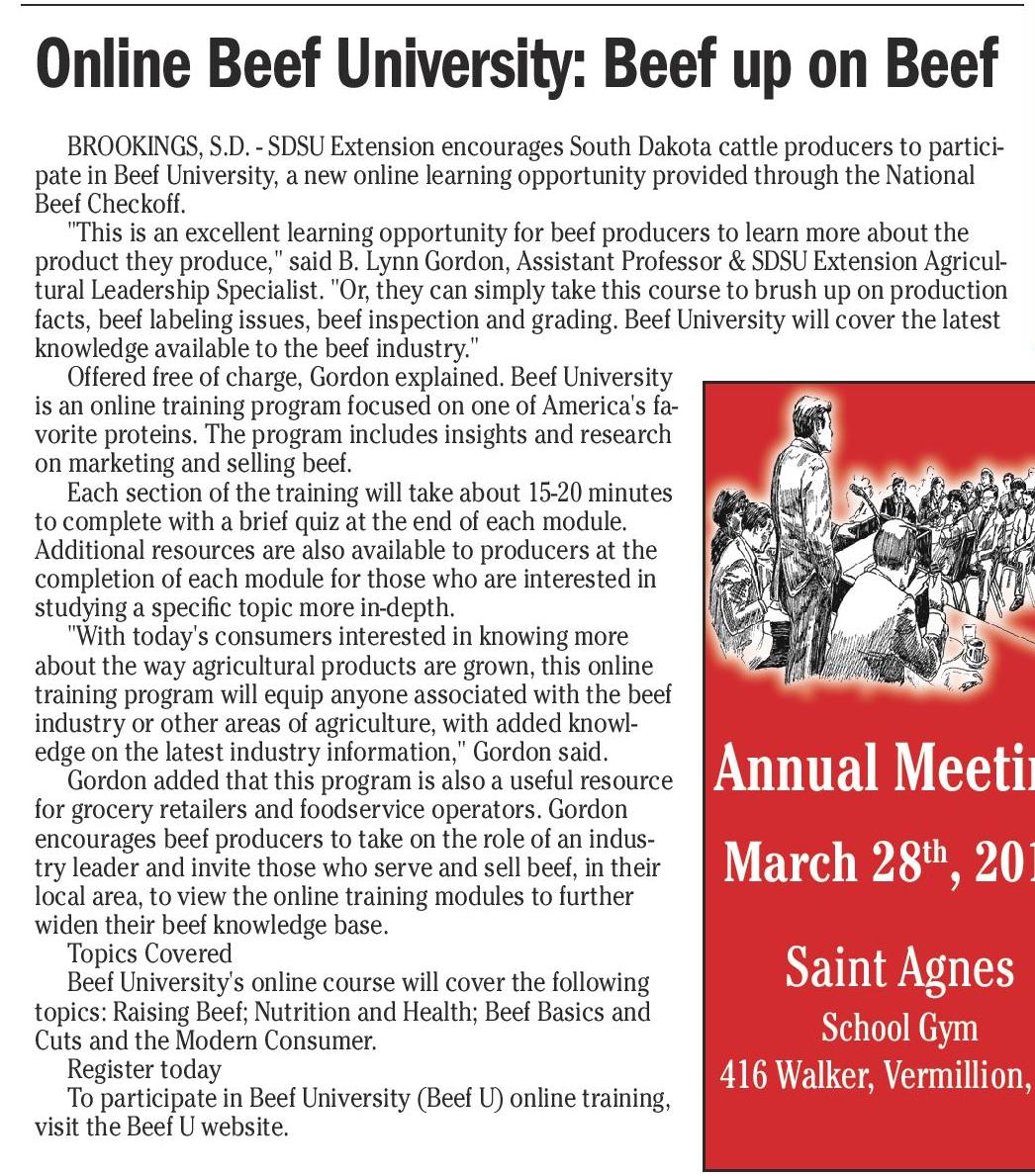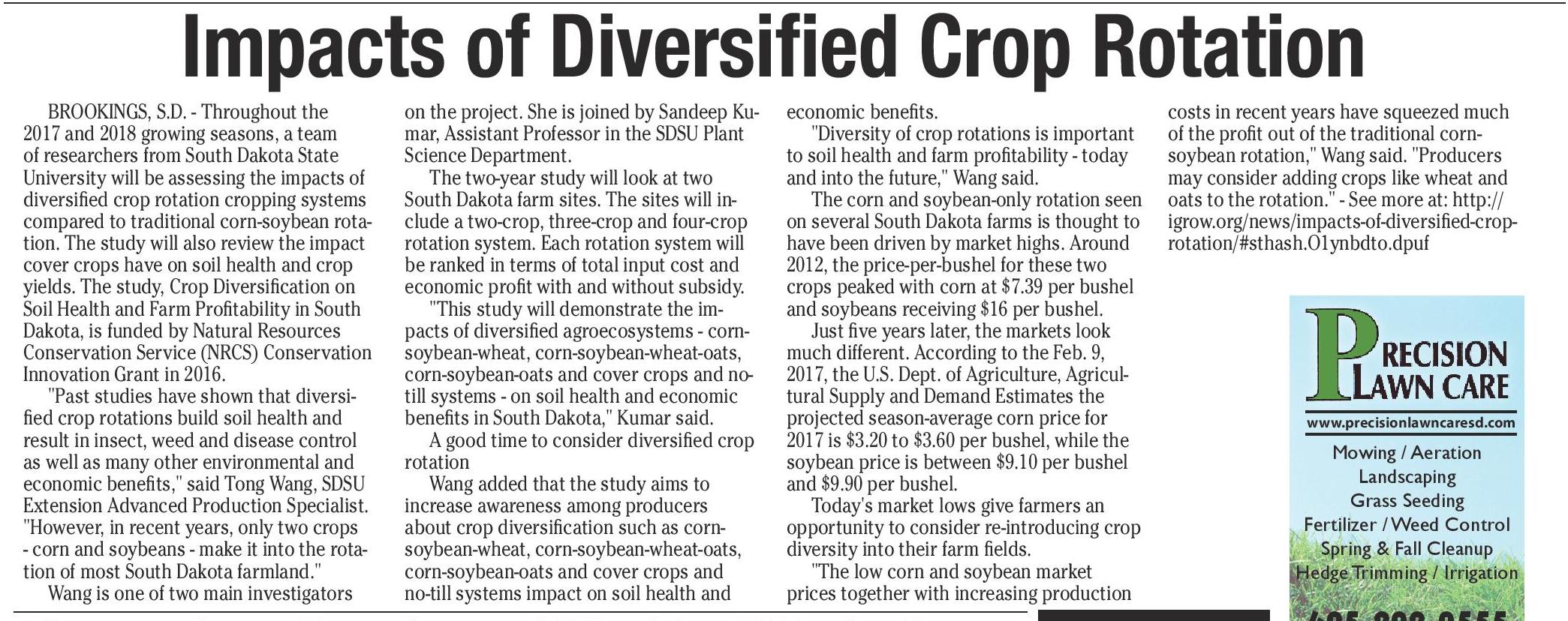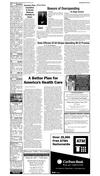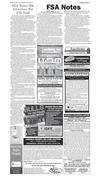031417_YKBP_A9.pdf








Broadcaster Press 9
March 14, 2017 www.broadcasteronline.com
Weekly Column: Repealing and Replacing Obamacare
By Rep. Kristi Noem
When we talk about healthcare, we’re
talking about something that is very
personal to people. It’s why I’ve so often
looked for ways to put you, the patient,
in control of your own healthcare. Since
Obamacare came into play, however, rising
costs, shrinking options and increased
bureaucratic involvement has resulted in
control being taken away from patients and
their doctors.
I’ve heard from thousands of South
Dakotans about the burdens placed on
them by Obamacare. For instance, a retired
teacher from Sisseton saw her premiums
increase from $350 to $500 per month while
her out-of-pocket threshold increased from
$5,000 to $6,000. Higher costs, worse coverage.
A Sioux Falls small business owner had
once tried to cover 60 percent of his employees’ premium costs. But after Obamacare, premiums rose to the point that this
benefit wasn’t affordable anymore.
A family in Haakon County reached out
to me after their premiums increased 200
percent. A family in Milbank saw costs for
their son’s insurance rise from $89 per
month to more than $300. A woman in
Rosholt pays almost $250 more per month
for a plan that doesn’t include the benefits
she used most often.
While I could go on and on with stories
like this, I understand others have felt
greater security because of Obamacare’s
provisions. For years, we have fought to offer relief to those hurt worst by Obamacare.
The Independent Payment Advisory Board,
which could have led to rationed care for
seniors, was gutted. The 1099 mandate was
eliminated and some of the most burdensome taxes were delayed. Even after the
tweaks, however, Obamacare remains
beyond repair.
Earlier this month, House Republicans
put forward a new vision for health care:
one that offers Americans from all walks
of life the freedom and flexibility to get the
health coverage their family needs. This
legislation came about after years of debate
and the final stages were completed in close
collaboration with President Trump and his
administration.
The legislation eliminates Obamacare’s
individual and employer mandates. It abolishes 14 Obamacare taxes that take $1 trillion from American taxpayers every decade.
This includes taxes on prescription drugs,
over-the-counter medications, and medical
devices as well as the Health Insurance Tax,
based on legislation I authored, which could
cost the average family nearly $5,000 over
the next decade if it isn’t repealed.
The flawed Obamacare subsidies left
many behind, so this legislation replaces
them with monthly tax credits for low- and
middle-income Americans. These credits
range from $2,000 to $14,000 per year,
depending on a person’s age and family
size. You will finally be able to choose the
plan that’s right for you – even if that means
cheaper catastrophic coverage, which is
something Obamacare didn’t allow you
to do. In addition to the tax credit, states
will receive new resources to help people
out and Health Savings Accounts will be
enhanced and expanded to grant you even
more flexibility.
At the same time, health insurers still
won’t be able to deny coverage or charge
more money based on pre-existing conditions and young people will be allowed to
stay on their parents’ insurance until 26.
There is a lot packed into this legislation, so I encourage you to read through it
yourself at www.ReadTheBill.gop
Shortly after the language was released,
the House Ways and Means Committee,
which I’m a member of, had the opportunity
to go through section-by-section and debate
any edits folks thought should be made
to the part of the bill that fell under our
jurisdiction. Once all the committees sign
off, the full House of Representatives will
have the opportunity to debate and vote on
the bill. We expect this process to play out
over the next few weeks.
As I mentioned before, I understand
healthcare is very personal and it’s for this
reason I believe you should be in control
of it. That’s ultimately why I’m fighting
through this process to finally repeal and
replace Obamacare.
BROOKINGS, S.D. - Throughout the
2017 and 2018 growing seasons, a team
of researchers from South Dakota State
University will be assessing the impacts of
diversified crop rotation cropping systems
compared to traditional corn-soybean rotation. The study will also review the impact
cover crops have on soil health and crop
yields. The study, Crop Diversification on
Soil Health and Farm Profitability in South
Dakota, is funded by Natural Resources
Conservation Service (NRCS) Conservation
Innovation Grant in 2016.
"Past studies have shown that diversified crop rotations build soil health and
result in insect, weed and disease control
as well as many other environmental and
economic benefits," said Tong Wang, SDSU
Extension Advanced Production Specialist.
"However, in recent years, only two crops
- corn and soybeans - make it into the rotation of most South Dakota farmland."
Wang is one of two main investigators
on the project. She is joined by Sandeep Kumar, Assistant Professor in the SDSU Plant
Science Department.
The two-year study will look at two
South Dakota farm sites. The sites will include a two-crop, three-crop and four-crop
rotation system. Each rotation system will
be ranked in terms of total input cost and
economic profit with and without subsidy.
"This study will demonstrate the impacts of diversified agroecosystems - cornsoybean-wheat, corn-soybean-wheat-oats,
corn-soybean-oats and cover crops and notill systems - on soil health and economic
benefits in South Dakota," Kumar said.
A good time to consider diversified crop
rotation
Wang added that the study aims to
increase awareness among producers
about crop diversification such as cornsoybean-wheat, corn-soybean-wheat-oats,
corn-soybean-oats and cover crops and
no-till systems impact on soil health and
economic benefits.
"Diversity of crop rotations is important
to soil health and farm profitability - today
and into the future," Wang said.
The corn and soybean-only rotation seen
on several South Dakota farms is thought to
have been driven by market highs. Around
2012, the price-per-bushel for these two
crops peaked with corn at $7.39 per bushel
and soybeans receiving $16 per bushel.
Just five years later, the markets look
much different. According to the Feb. 9,
2017, the U.S. Dept. of Agriculture, Agricultural Supply and Demand Estimates the
projected season-average corn price for
2017 is $3.20 to $3.60 per bushel, while the
soybean price is between $9.10 per bushel
and $9.90 per bushel.
Today's market lows give farmers an
opportunity to consider re-introducing crop
diversity into their farm fields.
"The low corn and soybean market
prices together with increasing production
costs in recent years have squeezed much
of the profit out of the traditional cornsoybean rotation," Wang said. "Producers
may consider adding crops like wheat and
oats to the rotation." - See more at: http://
igrow.org/news/impacts-of-diversified-croprotation/#sthash.O1ynbdto.dpuf
Impacts of Diversified Crop Rotation
Oatmeal is a Popular and Healthy Whole Grain
BROOKINGS, S.D. - Oats are one of the most affordable,
popular and healthy whole grains in America.
"Seventy-five percent of U.S. households have oatmeal in
their cupboards," said Ann Schwader, SDSU Extension Nutrition Field Specialist.
Although many think about oatmeal being served in the
form of a hot cereal or porridge, Schwader explained that
oatmeal has found its way into a variety of baked goods
such as breads, granola and muesli - an uncooked cereal
consisting of grains, nuts and fresh or dried fruits.
"Oatmeal is an affordable, versatile and healthy food
choice," Schwader said. "For years we've been told to eat a
bowl of oatmeal a day and for good reason."
She explained that oatmeal is rich in fiber, lowers cholesterol levels and promotes heart health. "Oats can help you
feel full longer, which can help us maintain a healthy weight
once we've reached it," Schwader said.
The USDA's MyPlate food system, recommends that
Americans ensure that half the grains they consume are
whole grains. Whole grains, Schwader explained, are
exactly what they sound like - the entire grain including the
bran, endosperm and germ.
Even when the oat grain is milled and the hull is removed - these groats are still whole grain. "Even though the
oat grain is milled and the hull removed, it's still considered
a whole grain. As long as all of the grain's three original
parts - the bran, germ, and endosperm - are still present, in
the same proportions as when the grain was growing in the
?elds, a grain is a whole grain," Schwader said.
Add whole grains to your grocery list
Navigating the grocery store for whole grains can be
challenging. "Some foods that seem to be whole grains may
not be," Schwader said. She explained that it's important to
know what to look for.
"Look at the package and ingredient list. It needs to say
"100% whole wheat, whole oats, whole rye, or whole grain
barley" or list whole before the first ingredient on the ingredient list. If it's listed there, it's a whole grain,'" Schwader said.
The 100 percent whole grain stamp also makes it easy
for shoppers to spot whole grain foods. "The 100 percent
stamp lets you know that a food contains a full serving - 16
grams - or more of whole grains in each labeled serving and
that all of the grain is whole grain," Schwader said.
Types of Oats:
Oatmeal can be purchased in many different forms.
Schwader discusses these below.
Regular or old-fashioned oats: The groats are steamed
and rolled into flakes but are not cut. They cook in about 5
minutes on the stove top or 2 to 3 minutes in the microwave.
Quick oats: The oat grain has been cut into two or three
pieces, then steamed, and flattened. They cook in just 1
minute on the stove top.
Instant oats: This is a popular product in many households. With instant oatmeal, the oat grain has been
steamed, rolled very thin and cut into small pieces so that
the cereal can be prepared quickly.
Some instant oatmeal products have added sugar; read
the ingredient label of the product to know if there are extra
ingredients added.
Steel-cut oats: Steel-cut oats are not flattened, instead
the grains are cut into three pieces. When preparing steelcut oats, use 4 cups of water to each cup of oats. The cooking time for this method is 30 to 40 minutes.
Oat flour: A whole grain ?our that can be used in baking
or for thickening soups and stews.
Tips for making oatmeal-icious meals and snacks:
1.Use rolled oats in place of bread crumbs in meat loaf
or patties.
2.Add rolled oats to muffins, breads, cookies and other
desserts.
3.Transform oatmeal by adding a small handful of sliced
almonds or walnuts, dried fruit, or sprinkle with cinnamon.
4.Mix 1/4 cup unsweetened applesauce into a serving of
oatmeal.
5.Make overnight oatmeal. Place 1/2 cup regular or quick
oats in a container, stir in 1/2 cup nonfat milk and 1/2 cup
chopped blueberries, strawberries or apples. Refrigerate
overnight and enjoy in the morning.
Note: A MyPlate 1-ounce serving of oats is the equivalent
of 1/2 cup cooked oatmeal, 1 packet of instant oatmeal, or
1-ounce (1/3 cup) dry regular or quick oatmeal. A 1/2 cup of
cooked oatmeal provides 70 calories, 2 grams of fiber and 3
grams of protein.
Find additional oatmeal information, nutrition tips and
recipes at Penn State Extension's Better Kid Care: The Appeal of Oatmeal - Lunches &
Snacks.
Online Beef University: Beef up on Beef
BROOKINGS, S.D. - SDSU Extension encourages South Dakota cattle producers to participate in Beef University, a new online learning opportunity provided through the National
Beef Checkoff.
"This is an excellent learning opportunity for beef producers to learn more about the
product they produce," said B. Lynn Gordon, Assistant Professor & SDSU Extension Agricultural Leadership Specialist. "Or, they can simply take this course to brush up on production
facts, beef labeling issues, beef inspection and grading. Beef University will cover the latest
knowledge available to the beef industry."
Offered free of charge, Gordon explained. Beef University
is an online training program focused on one of America's favorite proteins. The program includes insights and research
on marketing and selling beef.
Each section of the training will take about 15-20 minutes
to complete with a brief quiz at the end of each module.
Additional resources are also available to producers at the
completion of each module for those who are interested in
studying a specific topic more in-depth.
"With today's consumers interested in knowing more
about the way agricultural products are grown, this online
training program will equip anyone associated with the beef
industry or other areas of agriculture, with added knowledge on the latest industry information," Gordon said.
Gordon added that this program is also a useful resource
for grocery retailers and foodservice operators. Gordon
encourages beef producers to take on the role of an industh
try leader and invite those who serve and sell beef, in their
local area, to view the online training modules to further
widen their beef knowledge base.
Topics Covered
Beef University's online course will cover the following
topics: Raising Beef; Nutrition and Health; Beef Basics and
School Gym
Cuts and the Modern Consumer.
Register today
416 Walker, Vermillion, SD
To participate in Beef University (Beef U) online training,
visit the Beef U website.
www.precisionlawncaresd.com
Mowing / Aeration
Landscaping
Grass Seeding
Fertilizer / Weed Control
Spring & Fall Cleanup
Hedge Trimming / Irrigation
Sell it Local!
605.202.0555
FREE
ESTIMATES
Use The Broadcaster
Classifieds!
624-4429
Grain Bin Dealer
IRRIGATION SALES & SERVICE
Irrigation PVC, Wire Installed, Well Drilling Domestic & Irrigation Pump Installation
WATERLINE & ELECTRIC TRENCHING
Tree & Concrete Removal, Site Clearing,
& Ditch Trenching
ALL TYPES OF DIRT WORK - FREE ESTIMATES
Bobcats • Crane • Dozers • Excavators • Grader
Grain Trailer • Scrapers • Side Dumps • Trenchers
Vermillion, SD (605)670-9567
Hartington, NE (402)254-2568
Licensed in SD, NE & IA
Cyberstalking
find out
what you
need to know
Contact
DVSOS
for more
information
605-641-5311
in Vermillion
Serving Clay, Union,
Turner Counties
in South Dakota
Clay-Union Electric Annual Meeting will be held
Tuesday, March 28, 2017 at the
SAINT AGNES SCHOOL GYM, 416 Walker, Vermillion, SD.
The meeting will feature reports on financial and work
activities of your co-operative as well as director elections.
REGISTRATION - begins at 5:00 p.m. Every member who registers will
receive a gift for registering at the meeting.
- The meal
p.m. We will
again feature seating tables for your convenience.
Annual Meeting FREE MEAL 6:00 p.m.atwill be served from 5:00 - 6:00Business meeting
will start at
March 28 , 2017
Saint Agnes
CHILDREN’S PROGRAM - For the children attending the meeting with
their parents, we will provide supervised children’s entertainment in a
separate room during the business portion of the meeting.



















 Previous Page
Previous Page






